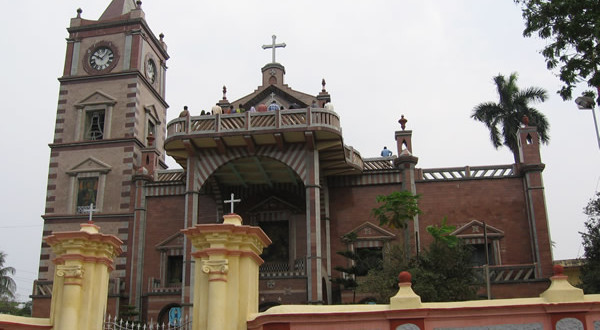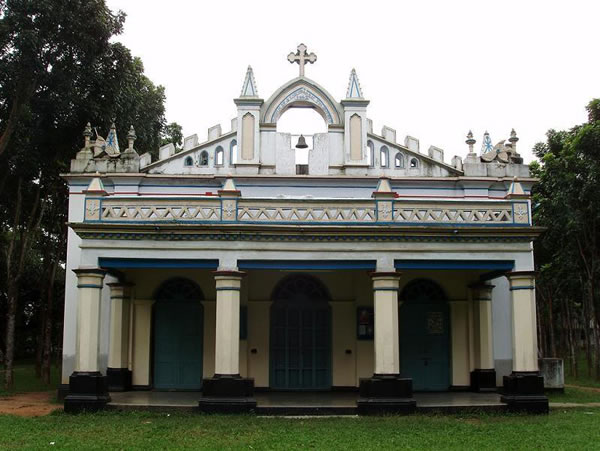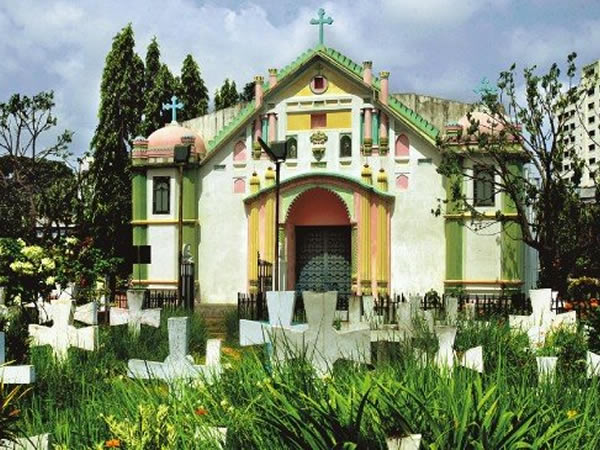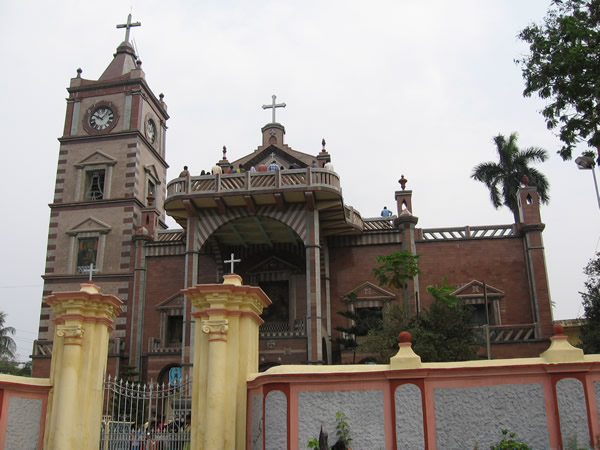Written by Prof. Stefan Halikowski Smith, Dept. of History, Swansea University.
The Bengal mission was one of the most Christian successful mission-fields in the Orient in early modern times, despite relatively small numbers of active missionaries. However, the mission, despite its successes in ‘harvesting souls’, encountered bitter political vituperation between the two orders active here, the Augustinians and Jesuits, who fought it out amongst each other for the rights to this mission. While the Jesuits liked to call the otherwise controversial Guy Tachard ‘l’apôtre de Bengale’, the most successful churchman was perhaps António da Rozario, an Augustinian who pioneered bilingual catechistic dialogues such as Argument and Dispute Upon the Law between a Roman Catholic and a Braman, composed some time before 1680 in simultaneous Bengali-Portuguese translation, and which quickly became the norm for missionary endeavour elsewhere in Asia, such as Burma. He was also quick to promote usage of canticles, especially those dealing with ‘the Mysteries of the Rosary’. Rozario was the converted son of the King of Busna, a raja in Eastern Bengal, who was ordained in 1682 as an Augustinian, became known simply as Dom António and went on to bring between 27 and 30.000 people into the church. This number is corroborated from sources outside the Church: the French jeweller, Tavernier, reported that ‘in Ogouli [Hughli] alone there were no less than 8 or 9000 souls of Christians’, whilst in the rest of the kingdome ‘there were about 25 thousands’ (Travels in India, vol. II, p. 140).
While the Portuguese had frequented ports like Satgaon (known as ‘porto pequeno de Bengala’) from the 1580s, the Augustinians were the first religious order to make headway in Bengal, specifically in the ‘Kingdom of Chittagong’ where they came to administer three parishes.760 bighas of land were granted by firman by Shahjahan to the Augustinians in 1633, a year after the Hughli community’s notorious expulsion and summons to the Mughal court at Agra, of which there exists an early nineteenth-century Portuguese copy. Augustinian affairs are related in the Brevilogio de notícias das cousas e dos Sujeitos da Congregação da Índia Oriental dos Eremitas Agostinhos (Biblioteca da Ajuda, Lisbon, Cod. 49-I-51) and in Fr. Jorge da Presentação’s História dos Missões dos Padres Augustinianos na India dos princípios do 18 sécolo (see Arnulf Hartmann’s presentation of this text in Analecta Augustiniana, vol. LVII, 1994, pp. 193-341). The Augustinians had acquired a bad reputation in other missions, such as Siam, where they were described by the visiting Portuguese embassy of 1684 as ‘odd and somewhat deranged men’, and other churchmen there had written to the Viceroy that they be excommunicated and sent to a penal colony such as Solor or Timor (Halikowski Smith, Creolization and Diaspora, 2011, pp. 165-66). In Bengal, trouble erupted even within the order, with missionaries like Fray Pedro de Silveira ‘driven out of Bengal by his Superiors because of the scandals he had perpetrated’ (letter of Guy Tachard, ed. Cornelius Buckley, p. 35). Visiting missionaries with their sights set on the mission-grail of China, like Matteo Ripa, were shocked by the ignorant state of the priesthood, their ignorance of Latin and the ‘norms of the Catholic Reform’, and the persistence of heathen practices like the sun-worshipping ceremonies he described which took place in the Ganges (Memoirs of Father Ripa during Thirteen Years Residence, London: 1834, 27). But the Jesuits seem to have been no better. Guy Tachard S.J. relates at the turn of the eighteenth century how in the French stronghold (place), meaning Chandernagore, ‘there are French Jesuits, who similarly contradict the Augustinian fathers, laying claim to joint jurisdiction over the parish, and having buried a dead man, the Augustinian priests went with very many Portuguese to exhume him and take him to their residence, a matter of very great scandal to be sure, but that all things said reveals the very great liberty that is to be enjoyed there’ (Relation de Voyage aux Indes, 1690-99, p. 104). Outside observers, like John Burnell, who visited in 1712, was mugged by ‘rascally Portugueze soldiers’, who stole his sword, and was ‘credibly inform’d’ the Jesuit Superior himself had ordered so (Bombay in the Days of Queen Anne, p. 147). Unpleasant stories of such ‘insolence’ abound in the relics of Portuguese Asia.
Church structures, however, were left behind which have lasted up until the present day, although often times restored, and their scolours schemes changed. The Church of the Holy Rosary was built in 1677 around twelve ‘magnificent columns painted in a watered-down green. It was slightly grander than the church of St. Nicholas Tolentino, built in 1695 at Nagori, 35 km north-east of Dhaka, a straightforward rectangular shape with no side chapels, only one floor, a simple wooden beamed roof and a niched altar in the far wall. The nave’s floor was probably covered with Indian or Persian carpets, while niches around the main altar would have contained images of that most important and communicative icon of Christianity in the missions, the Blessed Virgin, or Virgin with Child.
These missions lasted right through until the nineteenth century as the diary of a visiting Archbishop of Goa in 1865-6, D. João Crisóstomo de Amorim Pessoa, testifies to (BGUC, Reservados, no. 1635), although with new evangelical movements in neighbouring Calcutta, many Portuguese forsook Catholicism for the Baptist church. The most substantial mission was at Bandel outside Hughli, where the fifth Bishop of Mylapore Father Francisco Laynes S.J. was buried in 1715, though Father H. Hosten, S.J. claims that the Jesuit house was never more than a small ‘collegium’ or residence, with two or three fathers and occasionally a lay brother (Bengal Past and Present, vol. VI, p. 218; vol. X, pp. 64-70; vol. XXVI, pt. I, p. 77). Other visitors of this period like the Abbate Matteo Ripa, later to found the Collegio dei Cinesi at Naples University, in 1709 also described the church as ‘very pretty’(‘Burnell’s Adventures in Bengal’ in Bombay in the days of Queen Anne, Hakluyt Society, no. LXXII, 1933, p. 145, note 3). It is reproduced here for readers, along with other churches constructed by the Augustinians in the province.
The Church of St. Nicholas Tolentino, Nagori, 1695.
The Church of the Holy Rosary, Tejgaon, Dacca, completed for the Augustinians in 1677. A restoration project of 1940 did no harm to the façade, but unhappily took away the mouldings of alternating arcs and triangles over the aisle windows, which had given character to the sides. In 2000 the church was restored once again under the sponsorship of the Gulbenkian Foundation.
The Basilica of the Holy Rosary, Bandel, Hughli, first built in 1599 to serve diocesan functions, burned down in 1632, but was re-completed in 1660.
While many of the platforms which sustained Roman Catholic religiosity in the East were silenced, perhaps most significantly the suppression of the Jesuit Order in 1773 and the recall of its priests back to Europe, some settlements, which revolved around the spiritual and educational activities of the religious orders, pretty much disappeared; they were gradually incorporated into the administrative machinery of British India, as was the case with Loricul in East Bengal (The Journals of Major James Rennell first Surveyor-General of India : written for the information of the Governors of Bengal during his surveys of the Ganges and Brahmaputra rivers, T.H.D. La Touche (ed.), Calcutta: Asiatic Society 1910, vol. III, 1910, n.3, n.39), or Bandel, to the north of Calcutta (G. Toynbee, Sketch of the Administration of the Hooghly District from 1795 to 1845, with some account of the early English, Portuguese, Dutch, French and Danish settlements. Calcutta, 1888, p.6). And yet, as travel guides report, the pious still made their way for the annual festival of the Novena, celebrated in November, which attracted ‘great numbers of Roman Catholics’ in 1882 (Newman and Co.’s Handbook to Calcutta: historical and descriptive with a plan of the city. 1882, Calcutta: W. Newman, 1882, 6). Today, the numbers of Christians in the area is no less significant.
Bibliography.
Alonso, Carlos. ‘Stato delle missioni agostiniane nelle Indie orientali secondo una relazione inedita del 1640’, sep. Analecta Augustiniana, Louvain, vol. 25 (1962), pp. 291-325.
‘Burnell’s Adventures in Bengal’ in Bombay in the days of Queen Anne, Hakluyt Society, no. LXXII, 1933.
Campos, Joachim Joseph. A history of the Portuguese in Bengal, London: Buttersworth& Co., 1919.
Celso Constantini, L’arte Cristiana nelle missioni (Roma: Tipografiapoliglotta Vaticana, 1940).
Hawkesworth, John. Asiaticus in two parts; Ecclesiastical, Chronological, And, Historical Sketches Respecting Bengal (1803).
Hosten, Henry. ‘The Marsden Manuscripts and Indian Mission Bibliography’, in The Bulletin of the School of Oriental Studies, vol. 3, no. 1, 1923, pp. 129-50. See also his contributions to Bengal Past and Present, vol. VI, p. 218; vol. X, pp. 64-70; vol. XXVI, pt. I, p. 77.
The Tejgaon church restoration work is detailed in Maria João Avillez, Portugal: As sete partidas para o Mundo, Lisboa: Temas e Debates, 2000, ch. 6.
‘Privilegios que o Imperador Mogol concedeo á caza do Bandel de Ugoly dos Padres Augustinianos da Congregação da India Oriental’, in O Chronista de Tissuary, no. 32, August 1868, pp. 60-2.
Rozario, António da. Argument and Dispute Upon the Law between a Roman Catholic and a Braman, c. 1680, published by the University of Calcutta, 1937.
 Colonial Voyage The website dedicated to the Colonial History
Colonial Voyage The website dedicated to the Colonial History






































































